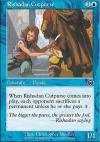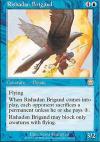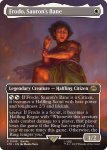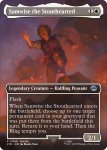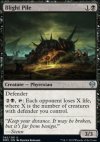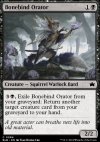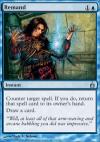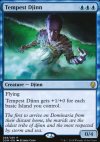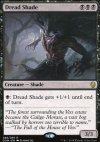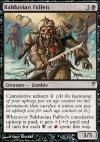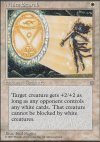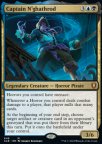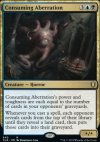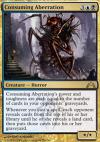|

MV anecdotes
| 4812 anecdotes trouvées |   |
Les cartes Sensor Splicer, Master Splicer et Blade Splicer forment un cycle vertical (cartes d'une même couleur mais avec une rareté différente) de l'édition New Phyrexia.
Elles sont complétées par Wing Splicer, Vital Splicer et Maul Splicer, de la même édition, pour former un cycle appelé "Splicer" et constitué uniquement de cartes blanches, bleues et vertes.
Les cartes Splicer's Skill, Ich-Tekik, Salvage Splicer, Darksteel Splicer et Vexyr, Ich-Tekik's Heir parues ensuite font référence à ce cycle.
Elles sont complétées par Wing Splicer, Vital Splicer et Maul Splicer, de la même édition, pour former un cycle appelé "Splicer" et constitué uniquement de cartes blanches, bleues et vertes.
Les cartes Splicer's Skill, Ich-Tekik, Salvage Splicer, Darksteel Splicer et Vexyr, Ich-Tekik's Heir parues ensuite font référence à ce cycle.
Les cartes Rishadan Cutpurse, Rishadan Footpad et Rishadan Brigand forment un cycle vertical (cartes d'une même couleur mais avec une rareté différente) de l'édition Mercadian Masques.
Les quatre cartes Frodo, Sauron's Bane, Samwise the Stouthearted, Gollum, Patient Plotter et The One Ring, de l'édition The Lord of the Rings: Tales of Middle-earth et illustrées par Marta Nael, forment une seule image, représentant la scène "Mount Doom" ("La Montagne du Destin" en français).
Source : Marta Nael ✨ (@MartaNael), le 8:23 PM · 31 mai 2023 a écrit :
Mount Doom scene (4 cards) for Magic Universes Beyond, Lord of the Rings: Tales of Middle-Earth
As a LotR fan, I'm truly thankful to Art Director Matt Cavotta for trusting me with this assignment 🥰
All the art that was created for this set is so stunning! 🥹💜
#MTGxLOTR
As a LotR fan, I'm truly thankful to Art Director Matt Cavotta for trusting me with this assignment 🥰
All the art that was created for this set is so stunning! 🥹💜
#MTGxLOTR
Les deux cartes Coral Colony et Blight Pile, de l'édition Dominaria United, forment une paire de créatures peu communes avec le défenseur et une capacité activée liée au nombre de créatures avec le défenseur que vous contrôlez.
À noter, la formulation de la capacité est légèrement différente et ce, au sein de la même édition.
À noter, la formulation de la capacité est légèrement différente et ce, au sein de la même édition.
Les cinq cartes Argivian Phalanx, Tolarian Terror, Writhing Necromass, Molten Monstrosity et Yavimaya Sojourner, de l'édition Dominaria United, forment un cycle.
Les dix cartes Tura Kennerüd, Skyknight, Rona, Sheoldred's Faithful, Garna, Bloodfist of Keld, Rulik Mons, Warren Chief, Queen Allenal of Ruadach, Aron, Benalia's Ruin, Najal, the Storm Runner, Uurg, Spawn of Turg, Tori D'Avenant, Fury Rider et Tatyova, Steward of Tides, de l'édition Dominaria United, forment un cycle de créatures légendaires bicolores peu communes soutenant chacune un archétype de formats limités.
Source 1 ("When you combine these five themes, you get the ten two-color archetypes") - Source 2 ("Draft, as an example, had a big influence on the uncommon gold cards that model Draft archetypes")
Source 1 ("When you combine these five themes, you get the ten two-color archetypes") - Source 2 ("Draft, as an example, had a big influence on the uncommon gold cards that model Draft archetypes")
Citation :
When you combine these five themes, you get the ten two-color archetypes:
White-blue – This is the combination of go-wide with instants and sorceries, so it's focused on generating a lot of tokens, protecting them, and then boosting them. Go wide strategies aren't traditionally done in white-blue, so this is pushing into novel space.
Blue-black – This is the combination of instants and sorceries and death. The end result is a control deck that uses card advantage to slowly eke out a victory.
Black-red – This is the combination of death and aggression. This results in aggressive creature strategy where you're rewarded for having your creatures die.
Red-green – This is the combination of aggression and ramp, so it's a mid-range creature deck that makes use of some domain cards.
Green-white – This is the combination of domain and go wide. This deck splashes extra colors to use domain as a tool to reinforce your attacking army.
White-black – This is go-wide plus death, which means it's a deck about creating a lot of small creatures that you then sacrifice for value. This ends up being a slower controlling deck than most go-wide strategies.
Blue-red – This combines instants and sorceries with aggression. That leads to a tempo-based spell deck.
Black-green – This combines death and ramp. This results in a mid-range deck that makes use of the graveyard.
Red-white – This combines aggression with go-wide that results in a typical aggro creature-based strategy, red-white's bread and butter.
Green-blue – This combines ramp/domain with instants and sorceries. It results in a base green-blue deck that splashes two to three colors and makes use of big domain effects.
White-blue – This is the combination of go-wide with instants and sorceries, so it's focused on generating a lot of tokens, protecting them, and then boosting them. Go wide strategies aren't traditionally done in white-blue, so this is pushing into novel space.
Blue-black – This is the combination of instants and sorceries and death. The end result is a control deck that uses card advantage to slowly eke out a victory.
Black-red – This is the combination of death and aggression. This results in aggressive creature strategy where you're rewarded for having your creatures die.
Red-green – This is the combination of aggression and ramp, so it's a mid-range creature deck that makes use of some domain cards.
Green-white – This is the combination of domain and go wide. This deck splashes extra colors to use domain as a tool to reinforce your attacking army.
White-black – This is go-wide plus death, which means it's a deck about creating a lot of small creatures that you then sacrifice for value. This ends up being a slower controlling deck than most go-wide strategies.
Blue-red – This combines instants and sorceries with aggression. That leads to a tempo-based spell deck.
Black-green – This combines death and ramp. This results in a mid-range deck that makes use of the graveyard.
Red-white – This combines aggression with go-wide that results in a typical aggro creature-based strategy, red-white's bread and butter.
Green-blue – This combines ramp/domain with instants and sorceries. It results in a base green-blue deck that splashes two to three colors and makes use of big domain effects.
L'illustration de la carte Squee, Dubious Monarch fait référence à la pièce de théâtre Hamlet, de William Shakespeare (voir aussi cette anecdote) : on y voit Squee, devant les squelettes de ses congénères gobelins, tenant le Squee's Toy comme Hamlet tient le crâne de son père, lorsqu'il prononce sa célèbre réplique : "To be, or not to be - That is the question".
L'illustration de la carte Bonebind Orator fait la même référence.
L'illustration de la carte Bonebind Orator fait la même référence.
On peut voir une Damping Sphere sur les illustrations des cartes Shivan Reef (à gauche du volcan) et Teferi's Contingency.
Les dix cartes Raff Capashen, Ship's Mage, Rona, Disciple of Gix, Garna, the Bloodflame, Hallar, the Firefletcher, Shanna, Sisay's Legacy, Arvad the Cursed, Adeliz, the Cinder Wind, Slimefoot, the Stowaway, Tiana, Ship's Caretaker et Tatyova, Benthic Druid, de l'édition Dominaria, forment un cycle de créatures légendaires bicolores peu communes soutenant chacune un archétype de formats limités.
Source 1 - Source 2 ("Draft, as an example, had a big influence on the uncommon gold cards that model Draft archetypes")
Source 1 - Source 2 ("Draft, as an example, had a big influence on the uncommon gold cards that model Draft archetypes")
Citation :
[...] This time around, we are taking a look at the Limited archetypes in Dominaria.
[...] we usually start out with the gold uncommons in the set. These gold uncommons can often act as sort of signposts for what each color pair is trying to do in that set.[...]
White-Blue Historic Fliers
Blue-Black Value
Black-Red Sacrifice Aggro
Red-Green Kicker Ramp
Green-White Tokens
White-Black Legendary
Blue-Red Wizards
Black-Green Saproling Sacrifice
Red-White Auras and Equipment
Green-Blue (sic)
[...] That was a whirlwind look at all ten archetypes in Dominaria Limited.
[...] we usually start out with the gold uncommons in the set. These gold uncommons can often act as sort of signposts for what each color pair is trying to do in that set.[...]
White-Blue Historic Fliers
Blue-Black Value
Black-Red Sacrifice Aggro
Red-Green Kicker Ramp
Green-White Tokens
White-Black Legendary
Blue-Red Wizards
Black-Green Saproling Sacrifice
Red-White Auras and Equipment
Green-Blue (sic)
[...] That was a whirlwind look at all ten archetypes in Dominaria Limited.
Les cinq cartes Memorial to Glory, Memorial to Genius, Memorial to Folly, Memorial to War et Memorial to Unity, de l'édition Dominaria, forment un cycle de terrains appelé "Memorial".
Les cinq cartes Benalish Marshal, Tempest Djinn, Dread Shade, Goblin Chainwhirler et Steel Leaf Champion, de l'édition Dominaria, forment un cycle.
Les cinq cartes Boreal Shelf, Frost Marsh, Tresserhorn Sinks, Highland Weald et Arctic Flats, de l'édition Coldsnap, forment un cycle de terrains neigeux. De plus leurs textes d'ambiance se font écho et sont tous en rimes.
Source ("Coldsnap had a cycle of five ally color snow dual lands that entered the battlefield tapped.")
Source ("Coldsnap had a cycle of five ally color snow dual lands that entered the battlefield tapped.")
Les cinq cartes Jötun Owl Keeper, Krovikan Whispers, Balduvian Fallen, Earthen Goo et Arctic Nishoba, de l'édition Coldsnap, forment un cycle.
Sur l'illustration originale de Daren Bader pour la carte Luminesce, de l'édition Coldsnap, le personnage porte une barbe, la lame de son épée est ensanglantée et son bouclier n'est pas luminescent.
Les cinq cartes White Scarab, Blue Scarab, Black Scarab, Red Scarab et Green Scarab, de l'édition Ice Age, forment un cycle appelé "Scarab".
Le personnage représenté sur la carte Captain N'ghathrod semble être inspiré de Davy Jones, un pirate à tête de poulpe, personnage de la série de films Pirates des Caraïbes.
Source 1 - Source 2
Source 1 - Source 2
Sur l'illustration de la carte Mahadi, Emporium Master, de l'édition Commander Legends: Battle for Baldur's Gate, peu de personnes remarquent que le personnage a les mains inversées.
L'illustration par Domenico Cava de la carte Consuming Aberration, de l'édition Commander Legends: Battle for Baldur's Gate, fait référence aux précédentes illustrations de cette carte. En effet, on y retrouve la forme plus "insectile" de l'aberration, en bas à gauche, ainsi que sa victime montant un escalier et portant une torche. Il semblerait donc qu'il y ait plus gros et plus dangereux dans les profondeurs des donjons...
Les cartes Executioner's Swing et Ultimate Price représentent le même personnage, l'assassin Orzhov surnommé "The Cozen" (traduit par "Le Mystificateur" en français).
Il est présent sur la liste des "Azorius 10 most wanted", dans laquelle il lui est reproché de faire un excès de zèle, en coupant un membre aux mauvais payeurs, et en choisissant la tête comme "membre" ; ce qui est d'ailleurs rappelé dans le texte d'ambiance de la carte Executioner's Swing.
Source ( 4) The Cozen)
Il est présent sur la liste des "Azorius 10 most wanted", dans laquelle il lui est reproché de faire un excès de zèle, en coupant un membre aux mauvais payeurs, et en choisissant la tête comme "membre" ; ce qui est d'ailleurs rappelé dans le texte d'ambiance de la carte Executioner's Swing.
Source ( 4) The Cozen)
Le personnage représenté sur la carte Feather, the Redeemed a un autre nom moins connu : Pierakor az Vinrenn D'rav. Ce nom est inspiré du mot slovaque "pierko", signifiant "plume".
Source
Source
Les cartes Cruel Celebrant et Cartel Aristocrat représentent le même personnage, qui a dû recevoir une promotion dans la guilde Orzhov et évoluer en vampire.
| 4812 anecdotes trouvées |   |






 Spider-Man / Omenpaths
Spider-Man / Omenpaths Edge of Eternities
Edge of Eternities Final Fantasy
Final Fantasy Tarkir: Dragonstorm
Tarkir: Dragonstorm Aetherdrift
Aetherdrift Foundations
Foundations Duskmourn
Duskmourn


